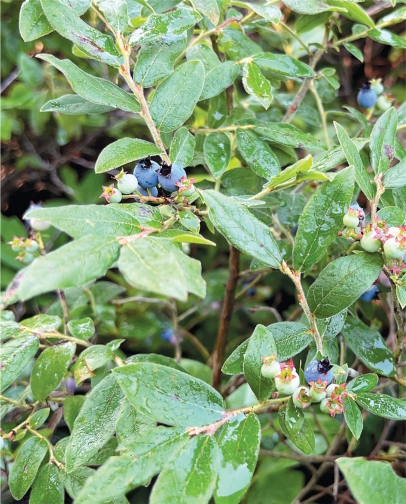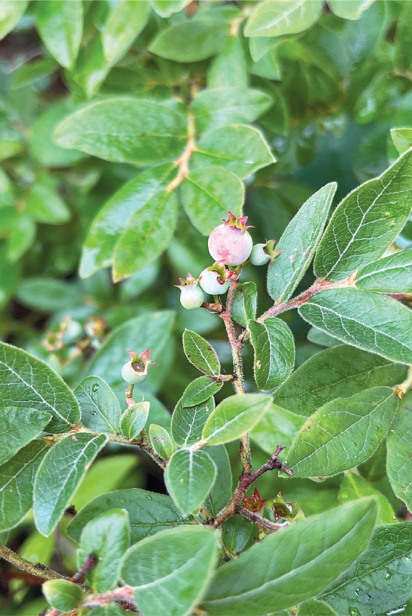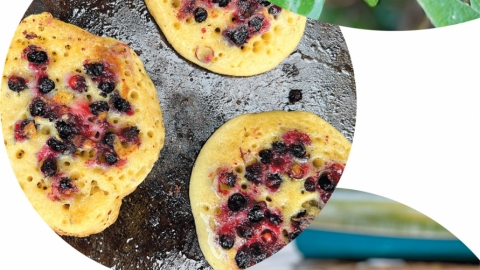Eating Wild: Finding Delight in the Simple Things with Wild Blueberries
In both foraging and in cooking, there are days when I can’t wait to dive into a complex, lengthy, or challenging project. Times when the activity I want to engage in is a time-consuming process that leads to an end result that feels earned.
Why do some of us search high and low, waiting for the moment when we finally spy that elusive morel mushroom, instead of finding fulfillment in the abundance of dandelion flowers that never attempt to hide from anyone? Why do we spend long hours making chocolate mousse instead of whipping cocoa into heavy cream and calling it a day? Sometimes all that work, and the knowledge that it won’t always work out, makes the outcome feel all the more special. It is its own sort of reward – the time, the effort, and, let’s be honest, the luck that some activities require.
Will the spot where I once found two lonely morels ever bring those coveted fungi my way again? Who knows, but how incredible if it does. Did my mousse set completely? Fingers crossed, and let’s dip our spoons in and find out.
Then there are the other days – which make up the majority of my days, at least – when we still want to find and harvest wild food, but don’t want the search to take ages and potentially end both literally and figuratively fruitless. Or when we still want to cook up a tasty dish, but a quick one that won’t have uncertain results. On days like these, there are few things quite as fulfilling as returning to a patch of previously discovered wild blueberries, spending a bit of time picking them off their stems, and cooking them into something exceedingly simple.
Just like their cultivated counterparts, wild blueberries come in lowbush and highbush varieties. While highbush makes up the majority of those commonly cultivated and harvested commercially, lowbush, or Vaccinium angustifolium, is what we most frequently think of when we’re harvesting from the wild. Lowbush blueberries bear much smaller fruit than their highbush cousins, and, as the name indicates, they are much shorter plants. This makes them both a smaller harvest by volume and a more difficult fruit to pick, which is why they are less useful as a commercial product. But luckily for foragers, they are not only more likely to be discovered in the wild, they are also quite a bit more flavorful than the large blueberries we buy at the store. They are one of the few wild fruits that I plan specific walking, hiking, and paddling routes around so I can return to particularly productive spots throughout the harvest season.
If you’re living in the Northeastern United States and have spent a bit of time near the rocky coast or in the mountains where the soil is dry and acidic, odds are you’ve been in the vicinity of wild lowbush blueberries, though you may not have noticed them if they weren’t fruiting at the time. Wild blueberry plants don’t necessarily catch your eye with flashiness or easily distinguished features during the spring and early summer, when their small leaves and tiny white or pinkish bell-shaped flowers are often overshadowed by flashier plants with bigger and brighter foliage and blossoms. It is quite easy to overlook wild blueberry plants, until one day in July or August, when you pass by a patch and see the fully ripened blue clusters of fruit out front and center. When you do happen on the plants at the right moment, you may discover that blueberries have simply always been a part of your “nature wallpaper,” subtly comprising one part of the tableau that has served as the backdrop to your neighborhood or favorite recreation spot.
A member of the Ericaceae family of plants – which also includes huckleberries and, the beloved Cape Cod standard, the cranberry – the wild blueberry has several identifiers that make it stand out from other low, bush-like plants in our greater region. Lowbush blueberry plants grow in a shrub formation and generally reach between shin height and a few feet tall. They bear small ovate leaves that grow in an alternate arrangement on woody stems. The plant has small flowers that grow in clusters with petals that are fused together creating that bell shape. These flowers end in five tiny points, which mirror the five-pointed crown at the end of the blueberry fruit itself. Blueberry fruit starts off as green, often with a bit of pink on the ends of the crown, and transitions from a lighter purple color to a deep, rich blue as it ripens. The ripe berries themselves are coated in a whitish powder, called a bloom, which is naturally forming yeast. Making sure that the crown end of the berries themselves are present and that you see this dusty bloom on the berry surface are excellent ways to begin your identification process.
Wild blueberries fruit throughout the mid to late summer, and when they are ripe they are often quite abundant. The dark blue berry clusters can be harvested by hand, pulling the fruit from a whole cluster at a time, though you will need to pick out any unripened fruit or stems that make their way into your harvest before using. Though they do often grow in places where it is possible to collect a good amount, both the time it takes to harvest and ensuring that you leave most of the fruit for wildlife and other foragers means that it is unlikely to harvest these tiny berries en masse. That is why I tend to use them immediately, and in simple recipes where they are a highlight instead of the headliner.
Using these tiny morsels to make an entire pie or a batch of jam is, in my opinion, not the best use of the fruit or of my day, since those recipes cook down so much of their already slight volume. Rather, I find the best way to prepare wild blueberries is in straightforward recipes similar to the ones in which I would use the even tinier and much more elusive (not to mention harder to harvest and far more perishable) wild strawberry. A morning’s harvest of wild blueberries works perfectly when tossed in a bowl of granola, scattered on top of a dish of ice cream, or mixed into a muffin batter at the last moment before baking. Or, as I find great delight in while out camping, added into a simple breakfast pancake or johnnycake.
Blueberry pancakes are, frankly, not complicated. And isn’t that just wonderful? They are a dish where the amount of effort you’ve taken to prepare a meal is in direct contrast to the enjoyment it brings. Sometimes we just need to whip up a quick batter, drop a few tablespoons of the sweet stuff onto a hot pan, and enjoy the finished product – drizzled with warm maple syrup – within moments.
While I will likely never stop trying to find those elusive forageables, quit testing out new baking techniques, or give up completely on complicated, hours-long cooking projects, I will always return to the small delights like wild blueberries and skillet breakfasts on sunny summer days. Because sometimes the littlest things are also the loveliest.
NOTE: Always consult with trusted experts and refer to foraging books and field guides for 100% positive plant identification before consuming any wild plant, and make sure you are familiar with every potentially dangerous plant that grows in your region. As with harvesting any wild plant, and particularly ones that grow in commonly sprayed areas, take particular care to collect from spaces you know to be chemical-free. Never pick any wild plant from protected spaces. Integrate new foods into your diet in small quantities to gauge any dietary and allergy sensitivities, and consult with a doctor if you have any questions or concerns about specific health issues or medication interactions.
Becca Miller lives in the Adirondack Mountains and works as a professional farm-to-classroom educator, ceramics teacher, writer, and photographer. A former Cape Codder in residence but always a Cape Codder at heart, Becca spent her time living on the Cape running a CSA program where she taught members how to use harvest items in new and creative ways. Becca is a Certified Master Food Preserver and a Leave No Trace Trainer, and her writing has been featured in Edible Capital District, Edible Vermont, and Adirondac magazines, along with Alice Waters’ Edible Schoolyard blog and Mother Earth Living’s Food Matters blog. Find Becca’s writing at beccamillerwriting.weebly.com.







